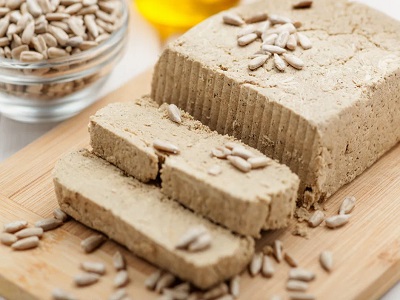How is Tahini Halva Production Made?
Tahini halva is one of our traditional Turkish foods that we love to eat. It is also called by various names such as Turkish honey, Turkish halvah and Turkish dessert by Western countries. Let's examine how the production of tahini halva, which has a solid, homogeneous and thin fiber appearance, takes place today.
First, let's talk briefly about how tahini, one of the raw materials of halva, is produced. Tahini is a sweet made from sesame. After the selection of sesame seeds suitable for tahini production, dehulling takes place in accordance with the technique. It is then roasted in the oven. The roasted sesame seeds are crushed in the mill to produce tahini. In addition to tahini, sugar, water, citric or tartaric acid and cedar juice are used in the production of halva. In addition to these, according to the type of halva to be made, substances such as walnut, peanut, cocoa and vanilla are added.
Syrup Handling (Malt Making)
Halva production starts with syrup production. Obtaining syrup, which we call malt; It is adding approximately 5-15% water into sugar and mixing it. Then boiling takes place at temperatures of 145 °C. Towards the end of boiling, citric acid is added. After the syrup is obtained, the bleaching process comes.
Bleaching and Waxing
After the syrup obtained is taken into the cauldrons, soapwort water is added into it. However, mixing takes place at temperatures of 130-140°C. Çöven juice is an important ingredient used in halva production. The effect of soapwort water on halva is as follows;
- It gives kneading feature during the processing of halva.
- It bleaches the color of halva. It provides a clear and beautifully colored halva.
- It provides a soft and fibrous structure.
- It provides volume increase.
- It acts as an emulsifier. In this way, it prevents the sesame oil from separating from the halva.
At the end of the process, a white, soft and spongy malt is obtained.
Mixing Process
The malt obtained is cooled to 70-80°C and poured on the tahini in a 1:1 ratio provided that it is at the same temperature. These two mixtures are mixed in the Tahini kneading boiler.
Rowing Process
Emulsifier or seasoning materials are added to the mixture taken into the kneading vessel, provided that it is in accordance with the formula. At the same time, additional tahini is added. The most important element in the shoveling process that takes place during the production stages of halva is the skill of mastery. Because the mixture has a mixing technique. This technique is about rowing one after the other. In this process, it is extremely important to make it quickly, as the mixture can cool quickly. This process takes place until the wax completely absorbs the tahini.
Kneading Process
Halva after the shoveling process is kneaded by the masters. The point to be considered here is that the fibers do not break. With the end of the kneading process, halva production takes place.
Molding and Cooling
Halva, which is produced, is cut by hand. Halva, which is divided into parts in this way, is weighted and goes into the molding process. Molded halvahs are left to cool for 12-24 hours under a certain relative humidity and air flow. After the products are cooled, they are packaged and offered for sale.

